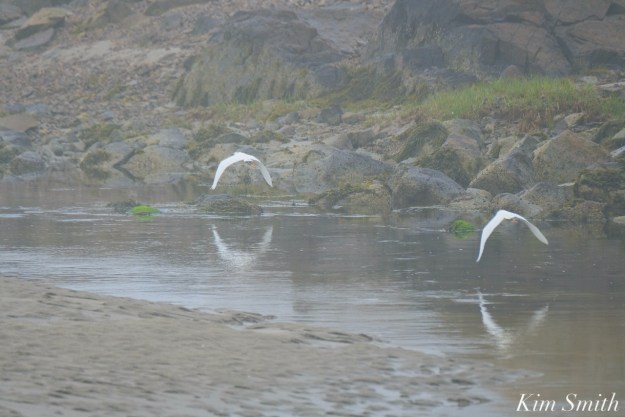Good Morning PiPl Friends,
Joyful update to share from Cape Ann PiPl nest check-up this morning –
 Cape Hedge
Cape Hedge
The Cape Hedge Plover parent’s are doing an excellent job guarding their clutch of four eggs, the most well-camouflaged nest in Massachusetts, as our state coastal waterbird biologist Carolyn Mostello refers to the nest. There was a Coyote scavenging around the wrack line near the nest but Mom and Dad went into full protective mode trying to distract. The “broken wing” display wasn’t too necessary though as the second the Coyote saw me, he/she hightailed into the marsh.
Area #1 Salt Island
Essex Greenbelt’s Dave Rimmer installed the exclosure at #1 (Salt Island end of the beach) yesterday afternoon and there are now three eggs in the nest! The Salt Island pair are not yet brooding full time and still continuing to mate. Quite possibly, we’ll have a fourth egg at #1. This little Mama has up to this point laid a total of six eggs, three in the first nest, which we think was predated, and three currently.
 Area #3 Saratoga CreeK
Area #3 Saratoga CreeK
In saving the best for last, our amazing handicapped Mom and ever vigilant Super Dad at #3 now have FOUR eggs in the nest. Mom popped off for a brief moment and I was “ploverjoyed” to see a fourth egg. I am not sure when this last egg was laid. It’s going to be a challenge to gauge when is the hatch date but I am working on that this weekend. *Borrowing the expression #ploverjoyed from our PiPl friends at Conserve Wildlife New Jersey 🙂
 GHB #3 Mom well-camouflaged on the nest this foggy, foggy morning
GHB #3 Mom well-camouflaged on the nest this foggy, foggy morning
Cape Ann’s current grand total of eggs in nests is Eleven (with a possibility of one more).
Yesterday morning, City Councilor Jeff Worthley and I met at Good Harbor Beach. He was very interested in learning about the Plovers and their history at GHB. Jeff agreed that Martha’s idea to speak before the next City Council meeting was a good plan; the next full council meeting is June 14th. He also suggested we do a brief presentation before City Council. The presentation has to be pre-planned and approved by City council president, Valerie Gilman. I don’t know if it’s either/or, or if we would be able to do both. What are your thoughts, PiPl friends? I think also we should definitely plan a “lessons learned” meeting at the end of the season, per Jonathan’s suggestion.
The Good Harbor Beach pre-reservation parking system goes into effect today. Some of the issues will be alleviated with the DPW and parking crew present, restrooms open, and end-of-the school-year high school senior parties behind us. We will still have issues with intoxicated persons tromping through the protected nesting area, but not the sheer numbers as the past two weeks, and hopefully we will see stepped up police enforcement on the beach.
A very brief Monarch update – Monarchs are here (first sightings by friends MJ on the 21st and Patti on May 23rd!) We see them in gardens, meadows, and dunes. Many other species of butterflies, too, have been sighted, including Tiger Swallowtails, Painted Ladies, American Coppers, Common Ringlets, and Spring Azures. May 23rd is early in the season for Monarchs. About every ten years or so we have an extra wonderful year with butterflies. The last was 2012. We are due and perhaps 2022 will be one of those years 🙂
Beauty on the Wing: Life Story of the Monarch Butterfly has been invited to screen at the Essex National Heritage Pollinator Week Program on the evening of June 22nd. For more information go here. Also, Beauty on the Wing is an official selection at the Santa Barbara Film Awards.
If anyone stops by GHB or CHB this weekend, please let us know. I feel fairly confident that the nests at GHB are safe, ensconced in their exclosures, but we like to check regularly nonetheless.
Have a wonderful Memorial Day weekend with friends and family,
xoKim
 Pair of Snow Egrets at Saratoga Creek
Pair of Snow Egrets at Saratoga Creek
Like this:
Like Loading...

















































































































































































































